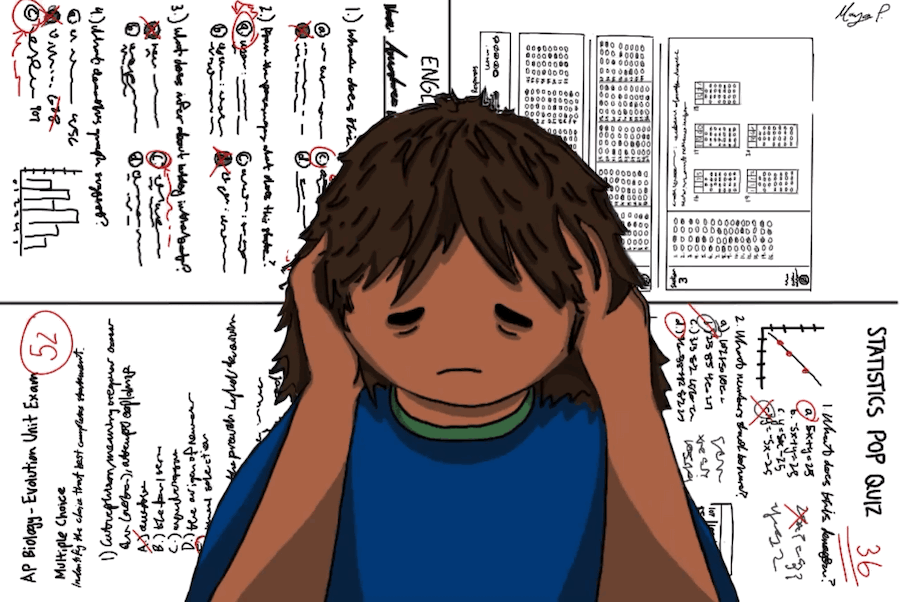The choice to end all choices
Standardized multiple choice testing has become a staple for high school education, but that does not mean it yields positive results. The Sidekick junior staff writer Anushree De examines the faults in this form of testing and advocates for reform.
September 12, 2022
Sweat beads condense on my forehead as I stare at the paper in front of me in utter confusion. The pencil in my hand trembles, perhaps as preposterously perplexed as I. And on the grand horizon of the white paper lies four letters: A, B, C and D. Just four possible choices: a 25% probability.
The answer should be easy enough, right?
I would think so too.
Multiple choice tests are nothing new. Since third grade, Texas students have become familiarized with the classic A-B-C-D questions in state standardized testing, such as the STAAR. This exact format seeps into our future lives, dictating our comprehensibility of the classes we take, becoming an integral part of the college admissions process and eventually determining our eligibility for graduate education.
Standardized testing is exactly that: standardized. It has been made to test the most people in the most efficient manner. But, they fail to consider the humanity within humans. For example, the SAT reading test. Let me set the scene, you’ve crossed out two answer choices, you have two more left, but you must “choose the best answer.” So, you choose what you think is the best answer, with sufficient reasoning and rationale. However, two months later upon receiving your score, that answer turns out to be wrong.
Does that mean you are not proficient in reading? Is it so impossible for you to have a different answer that is just as justifiable? Might you simply be thinking in a different way than the test expects?
The point is, multiple choice tests like the MCAT, LSAT, the bar exam and the GRE shape our very lives, which can become a problem. Everyone is different; it is that difference that propels us forward as each individual embraces their unique quirks. But multiple choice tests seem to take away that right when we are categorized into a score from which we are divorced in every way except one.
But even more fundamentally, multiple choice tests ironically seep the joy from the very standard of education they seek to uphold. Often operating in a vacuum, multiple choice tests offer no real world context as to why they are necessary to learn. The approach to pedagogy becomes a duty rather than the investigative venture it was meant to be.
There are other ways to measure proficiency in learning rather than summative tests, like communicative formats of testing. That is why the International Baccalaureate Programme centers around a conversation-based approach to learning rather than rigorous memorization for the sake of checkmarking a couple of restrictive educational requirements.
“Rather than sitting down and listening to a lecture, the entire class is structured so that all the students stand up,” Coppell High School junior IB student Hana Sawaf said. “We get a problem and solve it, and once you figure out how to solve a problem it’s like a lightbulb, because you’re able to solve any other problem [math teacher Ian VanderSchee] gives you.”
IB’s teaching approach stimulates students. Through a series of interactive approaches to learning, students are driven to become intellectually curious rather than stifled by a series of repressive requirements.
“It is most similar to the real world,” Sawaf said. “If you’re at a meeting you’re never going to take a multiple choice test, but you’ll talk in a group and work with a team.”
It would be wrong to say that multiple choice tests are absolutely distasteful. In fact, they can often be a metric to determine what schools may need to reform. However, irrespective of that benefit, the disproportionate effect that socioeconomic status has on multiple choice tests cannot be ignored.
For decades, high income students have had substantially higher scores than their low income counterparts. It makes sense. The SAT ($55), ACT ($88) and AP exams ($96 per exam) are expensive. For lower income households, retesting for a better score is often foregone for food or other necessities due to financial constraints. Studying for multiple choice tests also takes away valuable time that could be used to work a job.
“I would take practice tests two to three times a month leading up to the test,” CHS junior Tanvi Nikam said, who took the SAT on Aug. 27. “I set my standards last year at this time, and I worked to get to my goal.”
Even if tests offer waivers, it is difficult to ignore the million dollar industry surrounding test taking: SAT/ACT prep classes. Even though free resources can be posted online, prep classes offer strategies that are guarded by the golden ticket of money.
The wealthy receive better results simply because of the opportunities their privilege affords them.
Despite the doomsday feel, we are actually making progress. More than 1,835 colleges and universities have test optional policies. College admissions are shifting to a more holistic process, so while multiple choice tests are a section of college applications, they are not the be-all-end-all they used to be.
Internationally, the value afforded to multiple choice tests is a different story. Several Asian countries (including China, Japan, Vietnam and India) evaluate students based on a single university entrance exam.
One. Singular. Score.
It is no surprise then, that children as young as 8 are sent to cram school to master the exams when they can barely use their times tables.
So, studying for all these multiple choice tests makes me a smarter person right?
No.
“Multiple choice exams often close us off from understanding the concept,” CHS senior Umang Vinayaka said. “You’re forced to pick one option even if you know the concept. You might not see the option you know the best.”
Multiple choice exams bring on a certain different skill by examining which students are good at “test taking.” At its core, multiple choice tests focus neither on the joy of education nor the thrill of learning, but on a mundane number assigned on a report card. Multiple choice tests don’t care for genuine knowledge, but for jotting learning onto papers for a momentary second only to be lost in the abyss of forgotten thoughts.
So, what do you think we should do about the multiple choice exam?
A. Keep
B. Reform
C. Discard
D. Find an alternative
Choose the best answer (or make your own)…
Follow Anushree De (@anushree_night) and @CHSCampusNews on Twitter.











